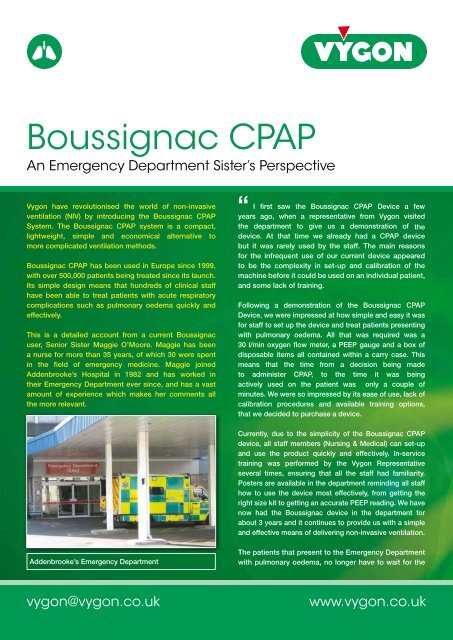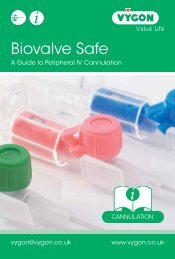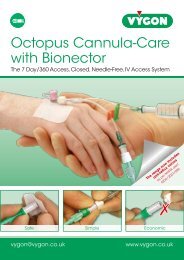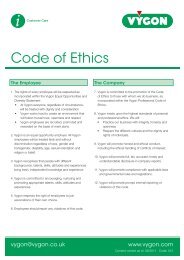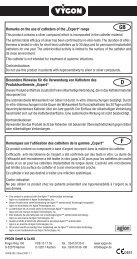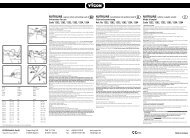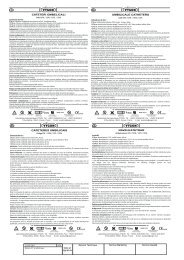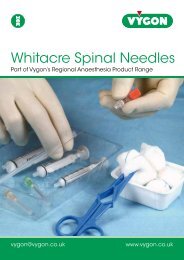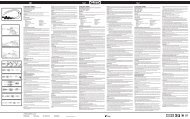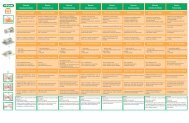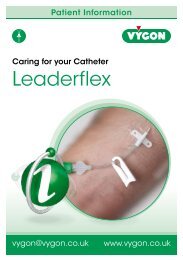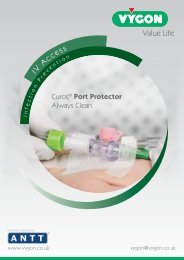Boussignac CPAP (300KB) - Vygon (UK)
Boussignac CPAP (300KB) - Vygon (UK)
Boussignac CPAP (300KB) - Vygon (UK)
You also want an ePaper? Increase the reach of your titles
YUMPU automatically turns print PDFs into web optimized ePapers that Google loves.
<strong>Boussignac</strong> <strong>CPAP</strong>An Emergency Department Sister’s Perspective<strong>Vygon</strong> have revolutionised the world of non-invasiveventilation (NIV) by introducing the <strong>Boussignac</strong> <strong>CPAP</strong>System. The <strong>Boussignac</strong> <strong>CPAP</strong> system is a compact,lightweight, simple and economical alternative tomore complicated ventilation methods.<strong>Boussignac</strong> <strong>CPAP</strong> has been used in Europe since 1999,with over 500,000 patients being treated since its launch.Its simple design means that hundreds of clinical staffhave been able to treat patients with acute respiratorycomplications such as pulmonary oedema quickly andeffectively.This is a detailed account from a current <strong>Boussignac</strong>user, Senior Sister Maggie O’Moore. Maggie has beena nurse for more than 35 years, of which 30 were spentin the field of emergency medicine. Maggie joinedAddenbrooke’s Hospital in 1982 and has worked intheir Emergency Department ever since, and has a vastamount of experience which makes her comments allthe more relevant.“I first saw the <strong>Boussignac</strong> <strong>CPAP</strong> Device a fewyears ago, when a representative from <strong>Vygon</strong> visitedthe department to give us a demonstration of thedevice. At that time we already had a <strong>CPAP</strong> devicebut it was rarely used by the staff. The main reasonsfor the infrequent use of our current device appearedto be the complexity in set-up and calibration of themachine before it could be used on an individual patient,and some lack of training.Following a demonstration of the <strong>Boussignac</strong> <strong>CPAP</strong>Device, we were impressed at how simple and easy it wasfor staff to set up the device and treat patients presentingwith pulmonary oedema. All that was required was a30 l/min oxygen flow meter, a PEEP gauge and a box ofdisposable items all contained within a carry case. Thismeans that the time from a decision being madeto administer <strong>CPAP</strong>, to the time it was beingactively used on the patient was only a couple ofminutes. We were so impressed by its ease of use, lack ofcalibration procedures and available training options,that we decided to purchase a device.Currently, due to the simplicity of the <strong>Boussignac</strong> <strong>CPAP</strong>device, all staff members (Nursing & Medical) can set-upand use the product quickly and effectively. In-servicetraining was performed by the <strong>Vygon</strong> Representativeseveral times, ensuring that all the staff had familiarity.Posters are available in the department reminding all staffhow to use the device most effectively, from getting theright size kit to getting an accurate PEEP reading. We havenow had the <strong>Boussignac</strong> device in the department forabout 3 years and it continues to provide us with a simpleand effective means of delivering non-invasive ventilation.Addenbrooke’s Emergency DepartmentThe patients that present to the Emergency Departmentwith pulmonary oedema, no longer have to wait for thevygon@vygon.co.ukwww.vygon.co.uk
For Acute Therapyequipment to undergo a more complex set-up orcalibration procedures prior to receiving treatment. In myopinion this has meant more rapid improvement in theirsymptoms. Some patients with severe shortness of breathhave improved so quickly with <strong>CPAP</strong> that they no longerrequire nitrate infusions or Coronary Care Unit admission.I would recommend that any Emergency Department inthe <strong>UK</strong> thinking about introducing a <strong>CPAP</strong> system shouldconsider the <strong>Boussignac</strong> system, as it offers a simpleand cost effective option.<strong>Boussignac</strong> <strong>CPAP</strong> Set-upThe above is my own opinion as a senior ED sisterand regular <strong>Boussignac</strong> user. I am not acting as arepresentative of my hospital Trust.Maggie O’MooreSenior Sister, Emergency Department, Addenbrooke’s Hospital.“<strong>Boussignac</strong> <strong>CPAP</strong> SystemFrom Maggie’s comments we can identify some key features of the <strong>Boussignac</strong> system that were of real benefitto the Emergency Department Sister and her team.Feature Benefit to staff Benefit to departmentPredominantly disposable(minimal hardware)<strong>Vygon</strong> training and support• Ease of use• No calibration required• Very quick set-up• Very cost effective• Comprehensive education and training• Posters displayed around department• All staff (medical/nursing) can apply thedevice• No costly servicing is required• Therapy administered sooner• Patient recovers quicker, before theydeteriorate further• Fewer drug infusions used• Fewer CCU admissions• Savings made, meaning more equipmentcould be purchased (small set-up costs)• All staff, nursing and medical are nowtrained on how to use the device• Giving staff relevant up to date information<strong>Boussignac</strong><strong>CPAP</strong> SystemFor further information on <strong>Boussignac</strong> please refer to the ‘<strong>Boussignac</strong> <strong>CPAP</strong>System’ literature, available on request from your local <strong>Vygon</strong> Sales Executive.vygon@vygon.co.uk www.vygon.com<strong>Vygon</strong> (<strong>UK</strong>) Ltd,Web: www.vygon.co.uk Email: customerservice@vygon.co.uk0008.<strong>CPAP</strong>/PERSP Content correct as of 11/08


